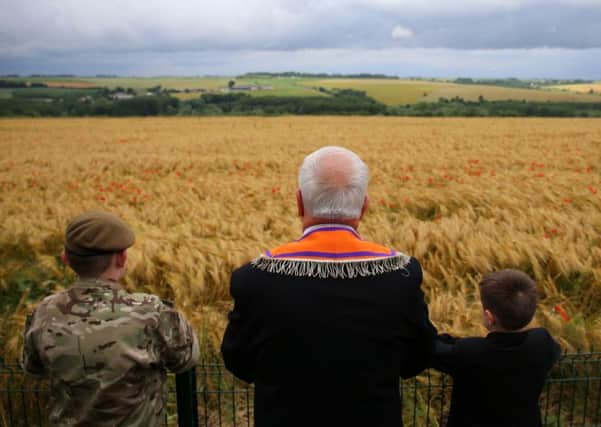Relatives gather at Ulster tower for Somme centenary


Relatives of those who died will join the Prince of Wales and Duchess of Cornwall, religious and political leaders for a martial ceremony remembering the British Army dead of a section of northern France which will be forever Northern Ireland.
The Ulster Memorial Tower lies amid the poppy fields, graveyards and preserved trenches where First World War artillery exchanges were fiercest and where lines of infantry walked to their deaths towards German defenders.
Advertisement
Hide AdAdvertisement
Hide AdIt was built on land gifted by the grateful French for the ill-fated attack British troops, from places like East Belfast, made against overwhelming defensive lines.
The Battle of the Somme began on July 1 1916 - a day that became the bloodiest in British military history with almost 20,000 dead - but which generals hoped would produce a pivotal victory for Britain and France over Germany.
With massive amounts of blood spilt by soldiers from across Ireland, the dead have been memorialised as martyrs for their country by unionists who forged the new Northern Ireland some five years later and increasingly their sacrifice has also been recognised by the Republic of Ireland.
The 36th Ulster Division’s initial attack near the Somme village of Thiepval was a success but the force could not hold territory gained.
Advertisement
Hide AdAdvertisement
Hide AdAt least 2,200 were confirmed dead during days of carnage involving faulty bombs and with failed communications, guides said.
Their shells landed on their own men and even the prevailing wind blew the gas back towards them.
Messengers carrying orders from headquarters to the front lines to retreat were killed and the troops never received them.
The bombs wobbled and never reached their targets - the Germans on the horizon - and often landed among their own men, according to guides at the Ulster Tower.
Advertisement
Hide AdAdvertisement
Hide AdA total of 2.5 million grenades were moved through Thiepval Wood, many using mules.
Among the relics recovered from archaeological digs were razors, combs and shaving brushes in perfect condition - a remnant of civilisation for men who spent days in the mud and squalor of the trenches.
Iodine used to treat infection, tins of corned beef and belt buckles were among the other traces of the soldiers retained.
Many of the dead and wounded were left in a bunker deep underground, according to records.
Advertisement
Hide AdAdvertisement
Hide AdTrenches have been preserved in the condition they were in, complete with bags which would have been filled with the chalky soil to provide protection.
Ms Villiers said: “Around 35,000 Irishmen - Protestants and Catholics, unionists and nationalists - were killed in the First World War.
“Their contribution and their sacrifice was immense, and we should never forget it.”
The Irish Government is represented by Heather Humphreys, Minister for Regional Development, Rural Affairs, Arts & the Gaeltacht.